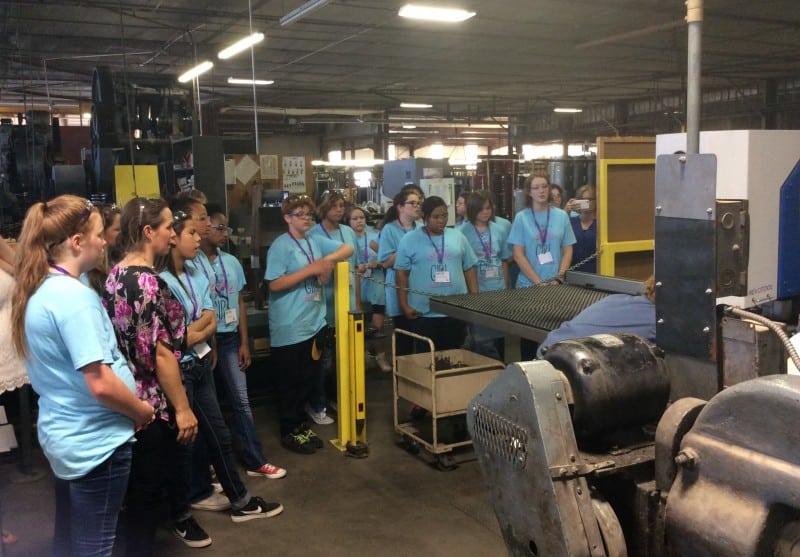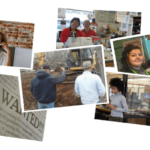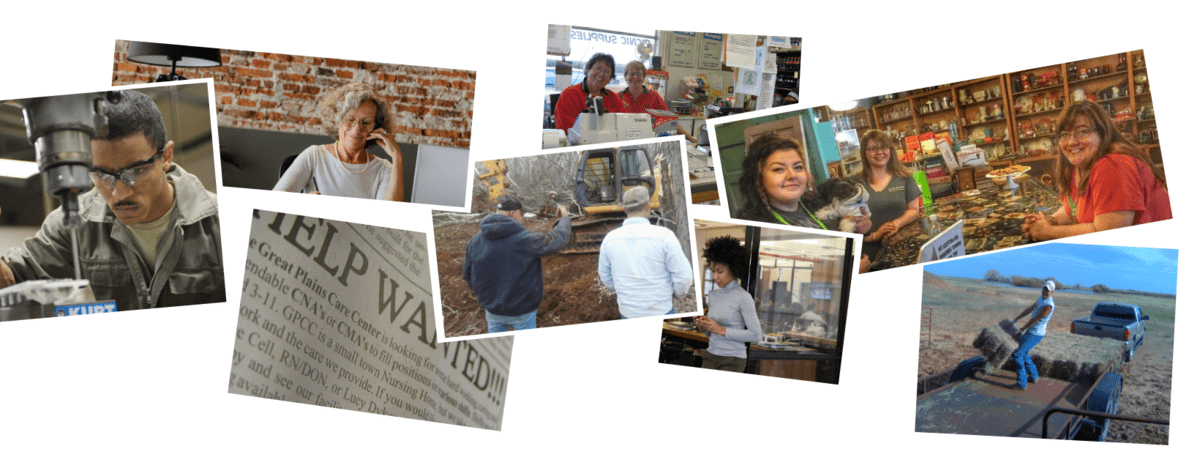Monthly Archives: January 2024
Improving the rural workforce: small town stories and takeaways
Takeaways for improving rural workforce: Bring together students, employers and multiple levels of education Build and document employee skills with micro-credentials Use apprenticeships to build skills, increase awareness of local job options Stitch together multiple programs to build your own workforce To add a new program in the public schools, hire dedicated program staff (at […]
Takeaways for improving rural workforce:
- Bring together students, employers and multiple levels of education
- Build and document employee skills with micro-credentials
- Use apprenticeships to build skills, increase awareness of local job options
- Stitch together multiple programs to build your own workforce
- To add a new program in the public schools, hire dedicated program staff (at least part time)
At the Teeny Tiny Town Summit held in Woodward, Oklahoma, a panel of local people addressed rural workforce challenges and what actions they were taking to address them.
The panelists were
- Barclay Holt, High Plains Technology Center, Woodward, Oklahoma
- Joe Cox, Oklahoma Works at Oklahoma Department of Commerce
- Brad Griffiths, Oklahoma State Regents for Higher Education
- Liz Leaming, Ponca City Development Authority, Ponca City, Oklahoma
And I’ll share some additional information from:
- Roger Knak, Fairview Regional Medical Center, Fairview, Oklahoma
Bring together students, employers and multiple levels of education
To encourage local students to consider additional local career options, High Plains Technology Center offers TAP (Technical Applications Program) for sixth through 10th graders, Barclay Holt said. The project is for career exploration that leads into the full-time training programs at HPTC. Think hands-on welding, tool and equipment use. All of the kids get to see and participate in all of the education areas. It is held at Woodward schools in their existing buildings, and at other schools across the HPTC district.
This brings together the two levels of education (career tech and public schools) in a way that didn’t require a lot of new investment. They also partner with community leaders, business owners, and parents.
Build and document employee skills with micro-credentials
Brad Griffiths explained UpskillOK.org, a micro-credentialing program of the Oklahoma State Regents for Higher Education. It offers a different way to approach employee training and development. Employers can collaborate with Oklahoma colleges and universities to develop a standardized credential for specific career skills. Other states and territories offer similar programs.
Just a few examples from the hundreds of current micro-credentials include:
- Government and Not-for-Profit Accounting
- Artificial Intelligence – Game Developer
- Mechanical Design
- Court Reporting Skills
Many of these also connect to industry certifications, like Google Career Certificates and CompTIA.
Higher education tends to measure courses in credit hours, and these micro-credentials include nine credit hours. These are smaller than the university certificates offered at some institutions, which take more hours. Micro-credentials can include learning through activities and projects, so they’re looking to connect with apprenticeship programs for work-based learning.
Use apprenticeships to build skills, increase awareness of local job options
Oklahoma Works Joe Cox has worked with local employers across the state to start apprenticeship programs in local businesses. When he started, most existing apprenticeships were in Oklahoma City or other metro areas. He has worked to expand to rural communities, including Watonga, Oklahoma.
He said it is a program that takes someone not necessarily fully qualified and gives them a chance at employment. The program has 97% retention rate. The apprenticeship can be a one to four year program. Cox often connects employers with the Oklahoma Department of Rehabilitation Services to help their clients connect with apprenticeship jobs.
Connecting students to existing local employers and jobs helps increase the chances to retain young people in rural communities.
Stitch together multiple programs to build your own workforce
Roger Knak with Fairview Regional Medical Center, Fairview, Oklahoma, presented on the health care panel, and he addressed how they build their workforce. Because they employ people in a variety of fields, they have to work with multiple workforce programs to grow their employees’ skills.
- They provide stipends to support their nurses with lower level CNA certification to complete their higher level LPN degrees.
- For their IT needs, they have a paid internship to work with their full time IT staff person.
- Their lab technicians complete online training through Barton County Community College from Kansas.
Roger told me that he wasn’t aware of the Oklahoma Works apprenticeship programs until this event. He planned to check how he could connect his IT internship to the state program. That is the power of holding local events and encouraging local networking.
Grow your own workforce
Ponca City, Oklahoma, has created multiple workforce programs. Liz Leaming from Ponca Works talked about growing their own workforce.
Ponca Works connects high school seniors who do not plan to attend college with local employers. Once per month all year the seniors meet with representatives from employers for Cookies and Careers. This encourages students to pursue local employment even if they don’t plan on college.
Ponca Works also uses augmented reality to give tours of local companies in a safer way. Some workplaces may not be set up for large group tours, or may have dangerous equipment. Using AR, students can get a virtual experience without compromising their safety.

Some workplaces can be toured, like Lindsey Manufacturing, maker of central vacuum systems. Other workplaces are safer to tour by Augmented Reality instead. Photo courtesy of Ponca City Development Authority.
Ponca City also offers a Girl Power STEAM camp. Here is how they explained the origin of the project:
When Ponca Works began there was a job posting for an office position with about 100 applicants, all female. At the same time there were dozens of jobs in the technical field that were open. It wasn’t a surprise, but more of a wake up call, at the large gap of girls and STEM careers. Girl Power exposes middle school girls to strong women with STEM careers in our community, hands on activities that teach exploration in science, technical skills, problem solving, critical thinking, and much more. We also tour facilities in Ponca City that offer careers in those fields. Our first campers will be entering the workforce next year, and we are excited to see what they are choosing to pursue.
Ponca Works also led a project to standardize all education and career players on a single evaluation tool so students could be evaluated once and move through any of the local workforce programs.
Liz mentioned that lots of kids are interested in forensic science, but it is a massively under-employed field with no direct employment opportunities locally. Drawing on similar skills, some students have been redirected into microbiology jobs which are available locally, such as the local manufacturer that needs lab analysis for their animal food supplements.
The Ambassador Program at Ponca Works trains younger employees at local businesses to share their story of local career opportunities with high school students.
To add a new program in the public schools, hire dedicated program staff (at least part time)
Ponca Works also offers a Wildcat Internship for juniors and seniors in high school. Students spend 1 to 3 hours a day at an employer. Around 30% of those students are paid. At the end of the program, around 10% get hired. There are 108 participating this year.
Before they hired a dedicated staffer at the schools, internship enrollment lagged. People at the school simply did not have capacity to manage yet another program.
Actions for rural employers to build their local workforce:
- Establish apprenticeship and internship programs: Apprenticeships and internships can help build skills and increase awareness of local job options. Look for state programs and projects to build support for internships and apprenticeships.
- Connect with multiple workforce development programs: Employers can provide stipends for employees to continue their education, connect with higher education micro-credentials and partner with educational institutions across geographic boundaries for specialized education.
- Engage with local schools: Employers can partner with local schools to offer programs to help students gain hands-on experience in various fields. Connect with high school seniors who do not plan to attend college and offer them employment opportunities. This can help retain young people in rural communities.
- Promote STEAM education: Employers can support local initiatives, camps, and programs that exist in the community.
- Hire dedicated program staff: If adding a new program in public schools, it’s important to hire dedicated program staff to promote the program effectively.
- Standardize evaluation tools: Work with educators and career specialists to agree on a single evaluation tool so students can take a single evaluation to use at any of the programs.
- Engage in local networking: Employers can participate in local events and networking to learn about new programs and opportunities.
More resources
- Grow Your Own Workforce, Katherine Long, CEcD, Ponca City Development Authority
- Reaching “at risk” kids for local jobs, two real-world examples, SmallBizSurvival
- Finding Good Employees: Rural Workforce Trends video, SaveYour.Town
99% of the best things you can do for your town don’t require anyone’s permission
Building community in your small town sounds like a daunting task. It’s easy to get bogged down, thinking there’s too much to do, that you’d need too many permissions or it would take too much money. The reality of building community is it’s a change of mindset to Take Small Steps. 99% of the best […]

Building community in your small town sounds like a daunting task. It’s easy to get bogged down, thinking there’s too much to do, that you’d need too many permissions or it would take too much money. The reality of building community is it’s a change of mindset to Take Small Steps.
99% of the best things you can do for your town don’t require anyone’s permission.
I’ve seen lists before of things you can do for your city, but none written for small towns. Let’s fix that. Here are 100+ small-town-approved ideas to build community.
- Hang out downtown, in the park, in plazas and pocket parks. Take a book or a snack. Invite friends. Have conversations.
- Cook extra and share with a neighbor.
- Introduce yourself when meeting someone new.
- Smile and remind people of your name.
- Walk. Park and walk to run errands. Park further from where you want to go.
- Hold a (music) jam session in your neighborhood or downtown.
- Bike. Bike your errands. Bike to work. Bike to the park.
- Make a list of everything in your town you can walk or bike to in 30 minutes. You might be surprised.
- Attend the arts and music events at local schools and colleges.
- Go to community performances and events. Cheer. Share praise online.
- Eat outside at local cafes and at picnic tables and benches downtown.
- Sit down for a meal with someone not like you. Someone from the community who is from a significantly different background, ethnicity, class, income level, or education. Listen.
- Spend more time in your front yard and on your front porch.
- Dress the front of your house to be inviting. Set out extra chairs and invite friends to join you.
- Drop in on the library and ask about what they have besides books.
- Start a hashtag for sharing good news and ideas in your town. Comment, like and share good things.
- Take pictures of things you like in your town and share them online.
- Shop the farmers’ market. Try something. Share pics online of what you cook.
- Walk into a local store. Take 5 friends. Spend $10 each.
- Walk into a local store. Take 2 pictures of something you didn’t know they had for sale. Post online.
- Start or join a walking or running group.
- Make and share a list of every public walking trail or meditation path in your town including those in parks, on church grounds, at schools or colleges, and along public waterways.
- Enter something you’ve created or grown in the county fair.
- Start a community betterment group. Pick items from this list or make up your own ways to improve your town.
- Plant a tree.
- Plant flowers in unexpected places.
- Dig and divide plants and put the new plants where others can see and appreciate them. Ask neighbors if they have plants you can divide and share.
- Start a positive hashtag for your community like #IfOurTown (#IfAlva or #IfPullman) and post positive things with it.
- Participate in art walks, downtown strolls and evening events.
- Hang string lights.
- Start a rock hunt. Find some small rocks, paint them and hide them outdoors downtown. Make a hashtag or online group so people can post photos when they find them.
- Plant an extra row in your garden to share.
- Grow a community garden with neighbors.
- Set up a table in a public place or at a farmers market to give away extra produce.
- Donate extra produce to the food bank.
- Put googly eyes on something. Use non-destructive adhesive like poster tack.
- Talk to your neighbors.
- Lead a photo walk. Invite friends to walk around and take pictures of good things. Notice things you like and share them.
- Host a street dance. Or empty lot dance or parking lot dance or…
- Start a sing-along. Anywhere, anytime.
- Wash the outside windows on an empty building.
- Pull weeds from public flower beds and boxes.
- Shovel snow for a neighbor.
- Talk to young people. Ask about what they want in your community.
- Sweep your own sidewalk.
- Find something that needs a simple repair, like a wooden flower box or a loose board on an empty building. Repair it.
- Work outdoors. Take your laptop for coworking in the park or at tables downtown.
- Carry a small trash bag when you walk or run to pick up trash.
- Send written thank you cards and letters to people who do good things in town.
- Start a Coffee and Calendars gathering. Invite people for coffee and ask them to bring the calendars and plans for any groups, organizations or boards they work with. Share community events and plans with each other.
- Make a cardboard playground. All you need is cardboard, scissors, tape, random material and stuff, and kids.
- Host a pop-up business from a local crafter or artist in a building or business you own.
- Plant herbs in empty flower boxes or pots.
- Paint a temporary mural on cloth, cardboard, coroplast (plastic sign material), or sheet metal. Hang it using magnets, sticky tack, or bungee cords.
- Put up directional signs to all kinds of things: parks, murals, art, businesses.
- Use your town’s waterfront, creek, lake or river. Mow and clean up a small patch and hold an open picnic to start. Talk about what you’d like to do or see. Can you boat or kayak?
- Add benches.
- Host a game night with your neighbors in your home.
- Host a game day at a local park.
- Create chalk art on sidewalks, bare walls, and retaining walls.
- Display fabric art everywhere.
- Host lawn croquet and invite your neighbors.
- Welcome newcomers to your town with a dinner or event.
- Hire a young person to help you out.
- Make and share a list of free activities in your town like public fishing, bird watching, or outdoor exercise equipment.
- Start a book club, painting club, or learning club.
- Feature local art for sale on the walls of your business.
- Paint something that needs it like a picnic table, bench or pole.
- Barter and trade with each other. Loan each other tools.
- Create a library of things: tools, cake pans, kitchen tools, musical instruments, all free to check out like library books.
- Start an Old Geezers Club, where older folks can bring their tools and share a workspace with anyone who wants to make something.
- Hold a repair cafe: bring together people who can fix things (including sewing) and let anyone bring anything that needs fixed.
- Make a free-stuff wall or space.
- Put out books for free in neighborhoods that are far from the library or near a gathering place like benches.
- Listen to stories from older people and people who are new in town. Document and share them.
- Hold a potluck with your neighbors.
- Start a poetry reading or writing marathon.
- Create a nature viewing area on your property.
- Return your broken paving (like cracked parking lots) to durable drivable grass.
- Start practicing yoga in the park and invite a friend.
- Give away extra plants or pots.
- Host a block party on your block.
- Host a community dinner, lots of people at one long table. Put conversation starters on the tables.
- Fill a box with outdoor toys. Place it at a local park in the mornings, and bring it in in the evening.
- Host neighborhood parents for an evening wrapping presents and putting together toys before Christmas.
- Show a movie outdoors.
- Mow an empty lot or a neighbor’s lawn.
- Improvise a public wading pool: kiddie pools, livestock water tanks.
- Improvise a public splash pad: drill holes in plastic pipes or a garden hose.
- Tell a traditional story or ghost story to young people.
- Display quilts or fabric arts on a railing, any railing.
- Set up a telescope and show people other planets.
- Add positivity to online groups. Volunteer to moderate comments.
- Use an empty building you own for an activity or event.
- Donate all or part of your building windows for community events or children’s art.
- Teach a workshop in a skill or craft.
- Add a public wifi channel to your business or personal router. Post a sign. Find public wifi anywhere in town and post signs so others can use it.
- Start a neighborhood cleanup. Clean your own yard and invite others to join you.
- Notice fruit and nut trees that go unharvested in public places. Harvest and share the crop with the food bank or senior center.
- Plant vines or flowers to grow up the public side of a fence.
- Decorate chain link fences with art or colorful slats.
- Make a “What to do in (town)” Pinterest board.
- Borrow an empty lot to start a popup market.
- Join a public art project like Stream of Dreams. www.streamofdreams.org
- Join a beautification project like America in Bloom. www.americainbloom.org
If you like these, reply and add your own ideas!
Updates
This post was originally published in March of 2019 and updated in January 2024 from 61 ideas to over 100.
Join Deb Brown and me at SaveYour.Town for a short video on Building a Unified Community.


